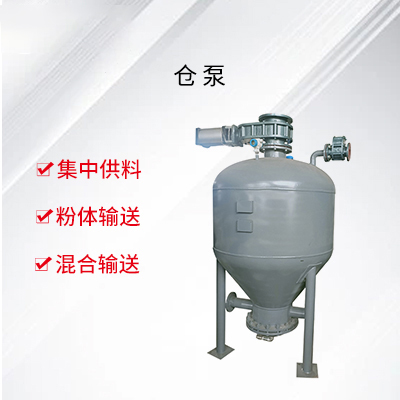倉泵,作為一種在工業領域中常用于氣力輸送粉狀、粒狀物料的設備,可能在很多人眼中只是一個普通的機械裝置,但它的制作過程卻蘊含著不少的學問和工藝。那么,倉泵究竟是如何被制作出來的呢?讓我們一起來揭開它的神秘面紗。
As a commonly used equipment in the industrial field for pneumatic conveying of powdered and granular materials, the bin pump may be seen as an ordinary mechanical device by many people, but its manufacturing process contains a lot of knowledge and technology. So, how is the warehouse pump made? Let's uncover its mysterious veil together.
首先,材料準備是基礎環節。制作倉泵,需要根據其使用場景和性能要求,選擇合適的金屬材料,常見的有鑄鐵、不銹鋼等。這些材料需要具備良好的強度、耐腐蝕性等特性,以確保倉泵在長期使用中能夠穩定運行。
Firstly, material preparation is a fundamental step. To make a warehouse pump, it is necessary to select suitable metal materials based on its usage scenario and performance requirements, commonly including cast iron, stainless steel, etc. These materials need to have good strength, corrosion resistance and other characteristics to ensure the stable operation of the bin pump in long-term use.
接下來是至關重要的泵體設計階段。設計人員要綜合考慮項目的各種工況,比如輸送高度、輸送距離、場地大小以及預期的輸送量等細節因素。只有經過精心設計,才能讓倉泵在后續使用中更好地滿足實際需求,實現高效、穩定的物料輸送。
The next crucial stage is the pump body design. Designers need to comprehensively consider various working conditions of the project, such as conveying height, conveying distance, site size, and expected conveying volume, among other detailed factors. Only through careful design can the warehouse pump better meet practical needs and achieve efficient and stable material transportation in subsequent use.
材料準備好且設計完成后,就進入到切割工序。根據設計圖紙上的尺寸要求,將原材料進行精準切割,為后續的加工制作奠定基礎。切割的精度直接影響到后續部件的組裝和整體的質量,所以必須嚴格把控。
After the materials are ready and the design is completed, it enters the cutting process. According to the size requirements on the design drawings, accurately cut the raw materials to lay the foundation for subsequent processing and production. The precision of cutting directly affects the assembly of subsequent components and the overall quality, so it must be strictly controlled.
然后是鍛造或鑄造環節。這需要根據倉泵的具體設計要求、使用環境以及成本等多方面因素來綜合考慮選擇哪種工藝。鍛造可以使材料的組織更加致密,提高部件的強度和韌性;而鑄造則能夠制作出形狀復雜的部件。有時,為了滿足倉泵不同部位的需求,還會將兩種工藝結合使用。
Then comes the forging or casting process. This requires a comprehensive consideration of which process to choose based on various factors such as the specific design requirements, usage environment, and cost of the warehouse pump. Forging can make the structure of materials denser, improve the strength and toughness of components; Casting can produce components with complex shapes. Sometimes, in order to meet the needs of different parts of the warehouse pump, two processes are combined and used.

完成鍛造或鑄造后,需要對部件進行熱處理。通過合理的熱處理工藝,如淬火、回火等,可以改善材料的組織結構,提高部件的硬度、強度和韌性等性能,從而提升倉泵的整體質量和使用壽命。
After forging or casting, it is necessary to perform heat treatment on the components. Through reasonable heat treatment processes such as quenching, tempering, etc., the organizational structure of materials can be improved, and the hardness, strength, and toughness of components can be enhanced, thereby improving the overall quality and service life of the pump.
熱處理之后,便是機械加工過程。這一步要對部件進行車削、銑削、鉆孔等操作,使其達到設計要求的精確尺寸和形狀,確保各個部件之間能夠完美配合。
After heat treatment, it is the mechanical processing process. This step involves turning, milling, drilling, and other operations on the components to achieve the precise dimensions and shapes required by the design, ensuring a perfect fit between each component.
機械加工完成后,還需要對部件進行表面處理。通常會采用打磨、噴砂等方式,去除部件表面的毛刺、氧化皮等,提高表面的質量和質感,同時也有助于增強部件的耐腐蝕性。
After mechanical processing is completed, surface treatment of the components is also required. Usually, methods such as grinding and sandblasting are used to remove burrs, oxide scales, etc. on the surface of components, improving the quality and texture of the surface, and also helping to enhance the corrosion resistance of components.
當所有部件都制作完成后,就進入到質量檢測環節。要對部件的尺寸、形狀等進行測量,檢查是否符合設計要求,還要對一些關鍵性能進行測試,確保質量合格。
After all the components are completed, it enters the quality inspection stage. It is necessary to measure the size, shape, etc. of the components, check whether they meet the design requirements, and test some key performance to ensure that the quality is qualified.
最后,就是裝配和整體測試了。將經過檢測合格的各個部件按照一定的順序進行組裝,形成完整的倉泵。組裝完成后,還需要對倉泵進行全面的性能測試,包括氣密性測試、輸送能力測試等,只有當各項指標都符合要求后,一臺合格的倉泵才算真正制作完成,可以交付使用了。
Finally, it's about assembly and overall testing. Assemble the various components that have passed the inspection in a certain order to form a complete warehouse pump. After assembly, a comprehensive performance test of the bin pump is required, including airtightness testing, conveying capacity testing, etc. Only when all indicators meet the requirements, can a qualified bin pump be considered truly completed and ready for delivery.
從一塊原材料到一臺功能完備的倉泵,這中間要經歷諸多復雜的工序,每一個環節都凝聚著設計者和生產者的心血。正是這些嚴謹的制作流程,才讓倉泵能夠在工業生產中發揮出重要作用,為物料的輸送等工作提供可靠的保障。
From a raw material to a fully functional warehouse pump, there are many complex processes involved, each of which embodies the efforts of designers and producers. It is precisely these rigorous production processes that enable warehouse pumps to play an important role in industrial production, providing reliable guarantees for material transportation and other work.
本文由倉泵友情奉獻.更多有關的知識請點擊:http://m.nrzyhzp.cn/我們將會對您提出的疑問進行詳細的解答,歡迎您登錄網站留言.
This article is dedicated to friendship For more information, please click: We will provide detailed answers to your questions. You are welcome to log in to our website and leave a message
聯系電話
二維碼
